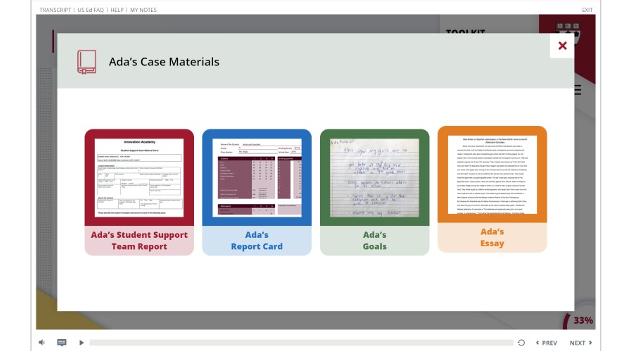Valuing Values: An E-Learning Case Study in Educational Ethics
“Promotion or Retention: A Dilemma in Educational Ethics”
Illumina Interactive, Inc. and Harvard Graduate School of Education
2021 International E-Learning Award Winner, Academic Division
The Dilemma: Promotion or Retention?
A decision regarding an underachieving student such as the one we see in the screen shot above—whether to hold her back, promote her, or propose an alternate school environment—is critical for the future of that student, and can be a very difficult decision for an educator to make.
These types of decisions must be made with the most information available on the student and with input from others in the school environment.
Still, even with lots of information and input, ethical dilemmas remain. Should a student be given extra leeway if they come from a challenging home environment? Should one take into consideration how other students may react to such a decision or how the decision would reflect on the school as a whole?
Answering these types of ethical questions requires a self-awareness of one’s own values and priorities and a way to grapple with competing values.
Teaching Educational Ethics
How to teach educational ethics has become a challenge in its own right. The Harvard Graduate School of Education and custom e-learning studio Illumina Interactive partnered to meet that challenge by designing an engaging, interactive, multimedia case study and then creating an online course around this case study. The goal of this course is to help users better understand the concepts, data and skills used during ethical decision-making.
Learners taking this course become engaged with the student in the case by sorting and then revisiting a list of ethical values (such as Care, Community, Justice, and Integrity). After becoming familiar with the details of a student’s case, learners are asked to make interim and then final decisions about how to handle the situation based on these values as well as the information and diverse views presented to them in the course.
The keys for learners are to understand what informed their decision, what questions still remain for them, and how their values evolved as they progressed through the case study.
Using this e-learning program in a blended format can then result in rich discussions in break-out sessions, especially among those of differing values.
This course is currently being taught at Harvard to both undergraduate and graduate students. It is also being used by professors teaching educational ethics courses at other universities, and in professional development sessions with educators and school and district administrators.
Sample Screens
Case materials include:
Ada’s Report card
Support Team Report – Ada’s academic strengths and weaknesses and behavioral information
An example of a report written by Ada and a listing of her own goals
Values to rank:
Accountability, Achievement, Care, Community, Consistency, Effort, Equality, Fairness, Integrity, and Justice.
Promotion or Retention: Working through the program
I went through the program choosing the role of Guidance Counselor (other possible roles were that of Teacher and School Administrator). These three groups of professionals comprised the team tasked with recommending retention or promotion for Ada, an underperforming eighth-grade student at Innovation Academy.
I was asked to rank—in importance to me—a list of ten values (see Values screenshot) and I got an opportunity to revisit my rankings after reviewing additional information.
I got a peek into Ada’s locker which, notably, included a picture of a recently deceased brother—a victim of gun violence. I also got to hear her in her own voice talking about school; her likes and dislikes.
The case materials I reviewed were both objective and subjective and included Ada’s report card, her support team report and her own essay and goals (see Case Materials screenshot). Feedback from other members of the eighth-grade team was also made available, both individually and through an extended group discussion, along with their faculty bios.
I got a full and rich picture of Ada, as a student and a person, as she struggles in a challenging environment. And, I had a difficult decision to make.
In the end, it was a judgment call with no right or wrong answer. And, most important was not what my decision was but how and why I had made it. And, understanding my own ethical decision-making process, I would be more confident of making future such decisions and more prepared and eager to discuss this decision with others with similar and dissimilar views.
About the author: Evelyn Levine works as a Training and Staff Development Director for the U.S. Courts. She writes on worldwide learning and development trends in public and private sectors. She can be reached at levinee@prodigy.net.



